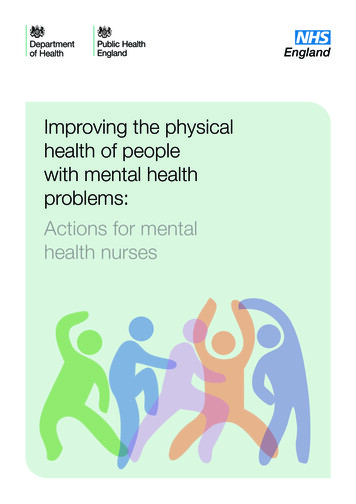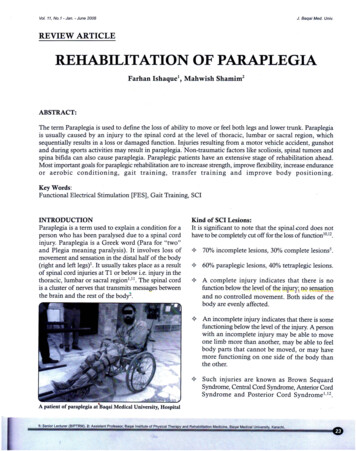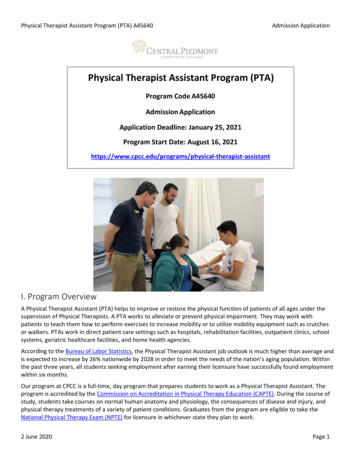
Transcription
EnglandImproving the physicalhealth of peoplewith mental healthproblems:Actions for mentalhealth nurses
Title: Improving the physical health of people with mental health problems: Actions for mental health nursesAuthor: Nursing, Midwifery and Allied Health Professions Policy Unit,Quality Division, Strategy and External Relations Directorate32400Document purpose: PolicyPublication date: May 2016Target audience: Registered mental health nurses; Directors of mental health nursing; Staff working inmental health and social care services; Lecturers and those who deliver professional training.Contact details:Dr Ben ThomasMental Health, Learning Disability and Dementia Care Professional OfficerNursing, Midwifery and Allied Health Professions Policy UnitStrategy and External Relations DirectorateDepartment of Health79 Whitehall, London, SW1A 2NSEmail: ben.thomas@dh.gsi.gov.ukNHS England Publications Gateway Reference 04603You may re-use the text of this document (notincluding logos) free of charge in any format ormedium, under the terms of the Open GovernmentLicence. To view this licence, ntlicence/ Crown copyrightPublished to gov.uk, in PDF format only.www.gov.uk/dh
ContentsForeword5Improving physical health and wellbeing a new resourceA holistic approach to physical and mental healthA commitment to action6Improving outcomes for people living with mental health problems10Metabolic syndrome and people with mental health problemsCardiovascular diseaseDiabetesRegular physical health checksHealth screening12Taking action: the role of mental health nursesWorking in partnershipKnowledge and skillsRightCare progammeCare planning141. Action on Support to quit smoking182. Action on Tackling obesity223. Action on Improving physical activity levels264. Action on Reducing alcohol and substance use305. Action on Sexual and reproductive health346. Action on Medicine optimisation387. Action on Dental and oral health428. Action on Reducing falls46Appendix 1 Assessment tools1. The Lester tool2. Integrated Physical Health Pathway3. NHS Screening4. Physical Activity Benefits for Adults and Older Adults50Appendix 2 References56Improving the physical health of people with mental health problems: Actions for mental health nurses3
AcknowledgementsEndorsementsThe Department of Health would like to thankthe many stakeholders who contributed theirexpertise and time to this resource.This resource is supported by the followingorganisations:British Heart FoundationOur particular thanks go to colleagues at:Central and North West London NHSFoundation TrustCity University LondonQueen’s Nursing InstituteRoyal College of NursingRoyal Pharmaceutical SocietyUNITE - Mental Health Nurses AssociationHealth Education EnglandLondon South Bank UniversitySouth London and Maudsley NHSFoundation Trust4Improving the physical health of people with mental health problems: Actions for mental health nurses
ForewordThe Five Year Forward View for Mental Health (2016) has onceagain highlighted that people with mental health problems havepoorer physical health than the general population, often theyare unable to access the physical healthcare they need andexperience unnecessary health inequalities.People with severe mental illness are particularly at risk and dieon average 15-20 years earlier than the general population. Beingin contact with mental health services does not necessarily meanthat people will have a physical health assessment, have theirphysical health monitored, or receive the information and supportthey need to adopt a healthier lifestyle.Mental health nurses have unparalleled opportunities to help people improve their physicalhealth alongside their mental health, both in inpatient settings and in the community. Buildingon their skills and knowledge this resource will assist mental health nurses to identify the keyrisk factors that are known to adversely affect the physical health of people with mental healthproblems. By following the activities to achieve change, and learning from the good practiceexamples in this resource, they can build up their confidence and expertise and makeimprovements to people’s health outcomes.The Government is committed to putting healthcare for people with mental health problems,including people with co-existing learning disabilities, on an equal footing with people withphysical problems. This means reducing unwarranted variation, so that individuals aresupported to live healthy lives, and are empowered to make real progress towards bringingtheir life expectancy in line with the rest of the population.NHS England has agreed that by 2020/21 at least 280,000 more people living with severemental health problems should have their physical health needs met. Mental health nursesare crucial to making these improvements, and to the Government’s goal of parity of esteem.Nurses must capitalise on the opportunities they have and make sure that people with whomthey have the most contact have their physical health needs met by early detection andaccess to evidence based care and interventions.This resource is a significant step forward encouraging mental health nurses to take an activerole to ensure people’s physical health needs are assessed and responded to. Drawing onthe available evidence it will improve the monitoring of and reduction of the risk factors thathave a detrimental effect on people’s physical health and ultimately reduce health inequalities.Alistair BurtMinister of State for Community and Social CareDepartment of HealthImproving the physical health of people with mental health problems: Actions for mental health nurses5
Improving physical health and wellbeing a new resourceThis resource is for mental health nurses,wherever they work, to take positive action toimprove the physical health of people living withmental health problems. It builds on work toensure parity of esteem between mental andphysical health by giving equal attention to thephysical health of people with mental healthproblems as is given to the general population.People with mental health problems should besupported to live healthy lives, and should beempowered to make real progress towardsbringing their life expectancy in line with the restof the population.The resource supports the Government’scommitment to ensure that people livingwith mental health problems have the sameaccess to health checks and healthcare as thegeneral population. It provides evidence basedinformation about ways in which mental healthnurses can improve the physical health andwellbeing of people living with mental healthproblems by tackling some of the key riskfactors for physical health problems.It complements other programmes of workunderway to address the physical health needsof people with mental health problems withinHealth Education England (HEE), NHS England,Public Health England (PHE), Royal Colleges ofNursing, Midwifery, Physicians, Psychiatrists andPharmacology and within national charities.While this resource focuses primarily on adultswith mental health problems including common6mental illnesses, severe mental illness (SMI) andpersonality disorder, it is important to recognisethat over half of all mental ill health starts beforethe age of 14 and 75% (excluding dementia)develops by the age of 181. Children with mentalhealth problems are at greater risk of physicalhealth problems, just like adults they are morelikely to smoke, drink alcohol and take drugs,undertake little physical activity and have poordiets, which contributes to poor physical health.The life chances of these individuals aresignificantly reduced in terms of their physicalhealth, educational and work prospects and lifeexpectancy.A holistic approach to physical andmental healthA holistic approach to managing mental andphysical health is needed. Physical and mentalhealth are inextricably linked and it is detrimentalto a person’s overall wellbeing to regard theseas two separate entities. There is strongevidence that having a long term mental healthcondition can be a significant risk factor for thedevelopment of physical ill health2. Converselylong term physical health conditions can lead topeople suffering poor mental health.People with SMI die on average 15 to 20 yearsearlier than other people3. This is mostly due tophysical health problems which are often notdiagnosed or managed efficiently and lifestylefactors which negatively affect physical health.Improving the physical health of people with mental health problems: Actions for mental health nurses
Key facts Mortality among mental health service users aged 19 and over in England was 3.6 times therate of the general population in 2010/11. People in contact with specialist mental health services per 100,000 service users, comparedwith 100,000 in the general population, had a higher death rate for most causes of death, inparticular: nearly four times the rate of deaths from diseases of the respiratory system at 142.2,compared with the general population at 37.3 just over four times the rate of deaths from diseases of the digestive system at 126.1,compared with the general population at 28.5 nearly three times the rate of deaths from diseases of the circulatory system at 254,compared with the general population at 101.1. Within these disease areas specific conditions that accounted for a high proportion of deathsamong service users (under the age of 75) were: diseases of the liver at 7.6% of deaths (1,430 in total) ischaemic heart diseases at 9.9% of all deaths (1,880 in total)4. The relative difference in mortality rates was largest among people aged 30 to 39: almost fivetimes that of the general population5. People with severe and enduring mental health problems have the lowest employment rate ofall groups of people with a disability at just 7%. There were 198 deaths of people detained under the Mental Health Act in 2013/14, themajority of which were due to natural causes, including preventable physical ill health6.Challenges across the system have contributedto the unacceptably large ‘premature mortalitygap’7,8. It is therefore imperative that people withmental health problems receive the physicalhealthcare that they require and have helpin accessing support to have more healthylifestyles.The Government has identified a national priorityto join up services across primary, secondaryand crisis care in order to promote equalaccess, early intervention, choice, and recoverybased on NICE quality standards of access forpeople with mental health problems.Better partnership between primary andsecondary care can help share expertise, instilconfidence and also help overcome barriers tohigh quality care. Good communication betweenall healthcare professionals involved in the careof those with mental health problems helps toavoid duplication or fragmentation of care. Whilemany NHS mental health and independentproviders have already begun to implementprogrammes to improve the physical health ofpeople living with mental health problems, thereis still unwarranted variation across the country.Improving the physical health of people with mental health problems: Actions for mental health nurses7
A commitment to actionThis resource is part of the Government’s commitment to a wider programme of work to improvethe physical health of people living with mental health problems. The NHS Five Year Forward View5 commits the NHS to take decisive steps to break down thebarriers in how care is provided between family doctors and hospitals, between physical andmental health, between health and social care. It recognises that: over the next five years the NHS must drive towards an equal response to mental andphysical health, and towards the two being treated together. The report from the Independent Mental Health Taskforce to the NHS in England6 has made anumber of recommendations. NHS England should undertake work to define a quantified national reduction in prematuremortality among people with severe mental illness, and an operational plan to beginachieving it from 2017/18. NHS England should also lead work to ensure that by 2020/21,280,000 more people living with severe mental illness have their physical health needsmet by increasing early detection and expanding access to evidence based physical careassessment and intervention. PHE should prioritise ensuring that people with mental health problems who are at greaterrisk of poor physical health get access to prevention and screening programmes. Thisincludes primary and secondary prevention through screening and NHS Health Checks,as well as interventions for physical activity, obesity, diabetes, heart disease, cancer andaccess to ‘stop smoking’ services. As part of this, NHS England and PHE should supportall mental health inpatient units and facilities (for adults, children and young people) to besmoke-free by 2018. By April 2017, HEE should work with the Academy of Medical Royal Colleges to developstandards for all prescribing health professionals that include discussion of the risks andbenefits of medication, and take into account people’s personal preferences, includingpreventative physical health support and the provision of accessible information to supportinformed decision making.8Improving the physical health of people with mental health problems: Actions for mental health nurses
A commitment to action cont NHS England is committed to working with PHE and a range of partner organisations toprovide a clear steer to commissioners about the evidence base relating to clinical interventionsand service developments which are likely to have the greatest impact. Achieving Better Access to Mental Health Services by 20201, sets out a clear vision to ensuremental and physical health services are given equal priority in terms of timely access to highquality services. It emphasises that ‘the physical needs of people with mental health conditionsneed to be assessed routinely alongside their psychological needs and vice versa’. The Commissioning for Quality and Innovation (CQUIN)9 payment framework enablescommissioners of services to reward excellence among providers of mental health servicesthrough the achievement of quality improvement goals. The CQUIN 2016/17 indicator 3a –Cardio metabolic assessment and treatment for patients with psychoses, aims to ensure thatpatients with SMI have comprehensive cardio metabolic risk assessments, have access tothe necessary treatments/interventions and the results are recorded in the patient’s recordand shared appropriately with the patient and the treating clinical teams. The cardio metabolicparameters based on the Lester Tool (see Appendix 1) include smoking status; lifestyle(including exercise, diet alcohol and drugs); body mass index; blood pressure; glucoseregulation; blood lipids. HEE’s workforce transformation programmes will include training in supporting the physicalhealth needs of users of mental health services in the children and young people, mentalhealth, learning disabilities and early interventions in psychosis. HEE will continue to support a wide range of training opportunities and resources developed ata local level by HEE local teams, in conjunction with higher education partners and academichealth science networks.Improving the physical health of people with mental health problems: Actions for mental health nurses9
Improving outcomes for people living withmental health problemsThere is overwhelming evidence from theMarmot Review10 on health inequalitiesthat addressing lifestyle factors alone willnot increase the life expectancy of peoplewith mental health problems. Mental healthnurses have an important role in addressingall determinants of health through assessing,referring, delivering and facilitating psychosocial,psychological and physical interventions.Recovery oriented services and peer-ledapproaches that address underpinning factorsof health inequalities will help individuals tomaintain social relationships, access goodhousing, employment and improve wellbeingand resilience, which will have a major impact onphysical and mental health.There is also evidence to suggest thatdiagnostic overshadowing can lead apractitioner to misattribute a physical healthsymptom as an expression of mental illnessrather than a genuine physical complaint11.Interventions that optimise physical, mental andsocial elements of health and wellbeing includehealth promotion to maximise prevention andreduce the risks associated with the onset ofillness, and ultimately lead to a reduction inpremature mortality.The action areas are: Support to quit smoking Tackling obesity Improving physical activitylevels Reducing alcohol andsubstance use Sexual and reproductivehealth Medicine optimisation Dental and oral health Reducing fallsThese action areas are addressed in moredetail in the following sections with a focus onthe main headlines associated with each risk,why mental health nurses need to take action,activities to achieve change, examples of goodpractice and a review of the evidence base forpractice.The reasons why people with mental healthproblems experience an increased burden ofphysical health needs are complex. These areidentified in the diagram on page 11.Eight key areas for action to improve healthoutcomes have been identified*. Each of theseareas is associated with particular risk factorsthat can have a detrimental effect on physicalhealth and reduce life expectancy.* The Department of Health carried out a survey of mental health providers about improving the physical healthof people living with mental health problems in 2014. The survey identified a number of successful interventionsthat can improve the physical health of people who receive mental health services. Interventions includedoffering physical health screening, promoting healthier lifestyles and inpatient services becoming smoke free incompliance with NICE recommendations.10Improving the physical health of people with mental health problems: Actions for mental health nurses
Interrelated dynamic elements affecting people’s physical healthStigma anddiscriminationPooraccess toservicesExposureto violenceand abuseLack ofphysicalactivityDiagnosticovershadowingPoor dietGeneticsPovertyMentalhealth andphysicalwellbeingHarmfuleffects ofmedicineSubstancemisuseDifficultiesin communicationLifestylechoicesSmokingLow Improving the physical health of people with mental health problems: Actions for mental health nurses11
Metabolic syndrome and people withmental health problemsPeople with mental health problems are likelyto be exposed to a combination of different riskfactors and have a higher level of metabolicsyndrome and co-morbidities than the generalpopulation.The physical health conditions making upmetabolic syndrome include: obesity high blood pressure raised blood sugar levels abnormal cholesterol levels.Individually, these health conditions can causedamage, but three or more together areparticularly dangerous, and increase the risk ofserious and life threatening illnesses includingheart disease, stroke and diabetes12.Metabolic syndrome is particularly commonamongst Asian and African-Caribbean peopleand women with polycystic ovary syndrome(PCOS). People with metabolic syndrome havea 3-6 fold increased risk of mortality due tocoronary heart disease and a 5-6 fold increasedrisk of developing type 2 diabetes13.Many psychiatric medicines, antipsychotics inparticular, are associated with increased risk ofmetabolic syndrome. Despite this, the majorityof patients receiving antipsychotic treatment inpsychiatric hospitals or general healthcare clinicsare not monitored for metabolic risk factors,even those that are simple to measure, suchas obesity and high blood pressure14. The lackof monitoring and interventions often meansmetabolic syndrome is underdiagnosed andundertreated among people with SMI.Cardiovascular diseaseCardiovascular or circulatory diseases (CVD),such as heart disease and stroke, accounted forjust over a quarter (27%) of all deaths (135,904)registered in 2014 in England and Wales, withischaemic heart disease accounting for 60,509(12.1%) deaths and stroke for 34,157 deaths15.The risk factors associated with CVD aresmoking, high blood pressure (hypertension),high cholesterol, diabetes, lack of exercise,being overweight or obese, a family history ofheart disease, and ethnic background. Theamount of alcohol people drink and how theydeal with stress are also thought to be linked16.DiabetesDiabetes is one of the most common longterm health conditions. In the UK there are 3.3million people diagnosed with diabetes andan estimated 590,000 people who have thecondition, but are unaware of it. In 2014, therewere 5,314 deaths from diabetes registered inEngland and Wales.The prevalence of diabetes has beenreported to be 2–3 fold higher in people withschizophrenia than the general population17.Increasingly, brief psychotherapeuticinterventions are being integrated as part ofdiabetes treatment and education, supportingtreatment adherence among service users ofall ages and helping to prevent some of thesuffering associated with the condition.People with long term physical conditions suchas diabetes, high blood pressure and obesityare also likely to experience mental ill health,such as anxiety and depression, as well associal isolation, low self-esteem, stigma anddiscrimination8.12Improving the physical health of people with mental health problems: Actions for mental health nurses
Regular physical health checksHealth screeningRegular physical health checks, which includelifestyle and family medical history and routinetests such as weight, blood pressure, glucoseand fats or lipids, can identify potential problemsbefore they develop into serious conditions,such as those described above.Health screening is an effective way to diagnosecertain conditions which can benefit fromearly diagnosis. The NHS provides a range ofpopulation health screening programmes toidentify people who appear healthy, but maybe at increased risk of a disease or condition.Information on current screening programmes isavailable on the Public Health England website18.Several tools have been developed to provideclear physical health monitoring standards forpeople with severe mental illness, such asthe Lester tool (see Appendix 1). Some NHStrusts have also developed their own tools toundertake appropriate health checks.Mental health nurses should support peoplewith mental health problems, who are eligible,to access these screening programmes (seeAppendix 1). For example, they can provideinformation about the screening programmesfor breast, cervical and bowel cancer; andabdominal aortic aneurysm, including theeligibility criteria and screening frequency.Improving the physical health of people with mental health problems: Actions for mental health nurses13
Taking action: the role of mental healthnursesThe person-centred, holistic nature of thetherapeutic relationship between mental healthnurses and service users means that nursesare ideally placed and have a vital role to play inprevention of physical ill health, increasing earlydetection of illness and reducing prematuremorbidity, enabling people to live healthier andlonger lives.Making Every Contact Count involvestailoring nursing activities and interventions toan individual’s needs. This includes providingpractical advice, support and solutions toempower individuals to make positive healthchoices and changes to their lifestyle, andensuring that they receive the relevant physicalhealth assessments and care that they need.19Working in partnershipWorking in partnership with other healthprofessionals and drawing on local knowledge,mental health nurses can identify key areasof support and resources for recovery acrosshealth and social care. They can makeconnections and manage referrals to easetransition from one service to another, acrossinpatient and community care, health andsocial care, specialist and community services,with appropriate guidance and support. Forexample, mental health nurses can collaboratewith pharmacy teams, both in hospitals and inthe local community to improve people’s health,focusing on areas such as smoking, alcoholand substance misuse, sexual and reproductivehealth and medicine optimisation.Some trusts employ registered adult nurses towork alongside mental health nurse colleaguesas part of the multidisciplinary team on acutemental health wards. This is proving valuable insupporting staff and service users to raise thephysical health agenda. Some trusts have alsoset up physical health link nurse meetings, todiscuss areas of practice and enhance sharedlearning.14Knowledge and skillsMental health nurses must make sure thatpeople’s physical, social and psychologicalneeds are assessed and responded to20. Theymust also recognise and work within the limits oftheir competence.There should be opportunities throughcontinuing professional development to acquirethe knowledge and skills needed to carry out theactivities identified in this resource.To help identify their own development needsmental health nurses will need to ask themselves‘Do I feel competent to do this?’ – ‘Do I needfurther training in additional skills, such asmotivational interviewing, or do I need to accessspecialist help?’Mental health nurses may need to identify howthey secure additional support and training ifthey lack confidence in particular areas, forexample, to discuss and address concerns orissues with individuals regarding their sexualactivity, or refreshing skills and knowledgeassociated with monitoring and recordingphysical observations and conditions, as well asthe physical side effects of medicines.The Department of Health has commissionedSkills for Health, Health Education England andSkills for Care to develop a Mental Health CoreSkills, Education and Training Framework21 forthe mental health workforce. The frameworkincludes supporting the physical health needs ofpeople with mental health problems, and will bepublished in 2016.RightCare programmeThe RightCare programme22 aims todemonstrate, through using a range of tools,where unwarranted variation exists and howto address it. RightCare includes the Atlas ofVariation series, which demonstrates that it ispossible to achieve better outcomes by lookingat local data, and asking whether the outcomesbeing achieved are as good as those achievedby the best.Improving the physical health of people with mental health problems: Actions for mental health nurses
The 2015 Atlas of Variation has more than 100maps covering a wide range of care includingmental health, which enable local comparisonsbetween clinical commissioning groups, NHStrusts, local authorities or NHS area teams,depending on the nature of the subject.RightCare shares best practice by providinglocal examples of innovations that demonstratethe philosophy behind RightCare, and has athree-stage approach to drive improvement.Step one: ‘Where to look’Because of the variety and comprehensivenessof its data, the Atlas of Variation represents anideal starting point for making comparisonsand identifying quickly which local servicesare outliers. It indicates where more detailedinvestigation should be focused to increasevalue.Step two: ‘What to change’Identifies exactly which aspects of servicescan be improved locally. This typically involvesa ‘deep dive’ into a particular care pathwayto gain more detailed insight into what isworking well, and what is not. This additionalinformation informs the case for change.Step three: ‘How to change’Proving the credibility and viability of theproposed change and then implementingit. This requires the disciplined use ofreliable processes, including programmemanagement, stakeholder engagement,analysis of the potential impact on serviceproviders and a sound business case.A framework for action Review the eight action areasidentified in this resource. Use the RightCare methodologiesto identify and reduce unwarrantedvariations in practice, in your area. Follow the relevant NICE guidelinesfor each action area. Consider the activities to achievechange for each action area in relationto the needs and care of individualsand the development of their careplans. Develop a person-centred action planfor each individual to address theirphysical health needs. Use the Making Every Contact Count(MECC)19 toolkit to focus on ‘changebehaviour’. Use the stages of care planning:‘assess’, ‘plan’, ‘implement’ and‘evaluate’ as a cycle to achieveimprovements in individuals’ physicalhealth and wellbeing.The RightCare programme can support mentalhealth nurses to identify and reduce unwarrantedvariation. Addressing unwarranted variation canhelp to narrow the gaps in relation to health andwellbeing, care and quality, and funding andefficiency.Improving the physical health of people with mental health problems: Actions for mental health nurses15
Care planning: exploring the potential for individualchange and improving physical healthAssessPlan Use a person centred approach toassess the individual’s current physicalhealth Work with the individual to create ashared care plan for improving theirphysical health and wellbeingSupport toquitsmoking Listen to the person, their preferencesand concerns Identify what is important to theperson, how they live their life and whatthey want to change Acknowledge and address theindividual’s fears and icalactivitylevelsDental andoral healthReducingalcohol andsubstanceuse Use an appropriate physicalassessment toolEvaluate Monitor and review progress with theindividual and refine and adjust care plansif necessary Discuss and record outcomes of specificactions and interventions with the individual Gather evidence on the impact of anychanges, for example by r
4 Improving the physical health of people with mental health problems: Actions for mental health nurses Acknowledgements The Department of Health would like to thank the many stakeholders who contributed their expertise and time to this resource.










